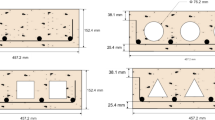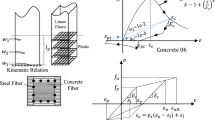Abstract
Nowadays, the diagnosis of degraded concrete in existing reinforced concrete structures and the evaluation of their structural capacity has become an important issue in the construction industry. The accuracy of core tests and their locations have a major role in the evaluation methodology and the accuracy of results. An incorrect or inaccurate interpretation of results or an undetected structural problem can lead to a failure or collapse of a building causing potentially loss of lives and materials. Generally, core tests are used in conjunction with non-destructive tests (NDT) for assessing concrete quality. Due to the budgetary constraints and with the aim of ensuring the structural integrity it is necessary to minimize the number of needed cores to estimate the concrete strength in structures without decreasing the accuracy of the assessment. Some researchers have tried to identify and optimize the number of cores that should stabilize the model error from synthetic data as well as more recently on real structures. There is a need for more case studies to draw better conclusions and to quantify the number of cores required to assess degraded concrete, which is not clearly treated in the recent recommendations of RILEM TC249-ISC. In this paper, both rebound hammer (RH) and Ultrasonic Pulse Velocity (UPV) tests in combination with core tests are used for the estimation of the concrete compressive strength in existing structures. These structures were built in the 1970s and have been degraded predominantly by steel corrosion. 234 and 86 structural elements were tested by RH and UPV, respectively. 36 cores were also drilled at NDT locations and tested under compression. The root mean square error (RMSE) and the coefficient of determination (r2) were used as statistical indicators for the evaluation of the accuracy of the non-destructive assessment in predicting concrete strength. The obtained results show that RH method accuracy in concrete strength assessment is more affected by the degradation of concrete compared to the UPV method. The minimal number that guarantees a sufficient precision of concrete strength assessment for combined or single NDT methods is nine cores.


























Similar content being viewed by others
Data availbility
Data is avilable upon special request.
References
Abdallah, W., Sbartaï, Z. M., Saliba, J., Elachachi, S. M., Hage Chehade, F., & Sadek, M. (2021). Assessment of the reliability of concrete evaluation by multi-physical inversion of NDT measurements—A probabilistic approach. Construction and Building Materials, 300(July). https://doi.org/10.1016/j.conbuildmat.2021.124371.
ACI 214.4R-10. (2010). Guide for obtaining cores and interpreting compressive strength results.
ACI 228.1R-03. (2003). In-Place Methods to Estimate Concrete Strength.
ACI 318-08. (2008). Building code requirements for structural concrete. American Concrete Institute.
Ali-Benyahia, K., Sbartaï, Z., Breysse, D., Ghrici, M., & Kenai, S. (2019). Improvement of nondestructive assessment of on-site concrete strength: Influence of the selection process of cores location on the assessment quality for single and combined NDT techniques. Construction and Building Materials, 195, 613–622. https://doi.org/10.1016/j.conbuildmat.2018.10.032.
Ali-Benyahia, K., Sbartaï, Z., Breysse, D., Kenai, S., & Mohamed, G. (2017). Analysis of the single and combined non-destructive test approaches for on-site concrete strength assessment : General statements based on a real case-study. Case Studies in Construction Materials, 6, 109–119. https://doi.org/10.1016/j.cscm.2017.01.004.
Alwash, M., Breysse, D., & Sbartai, Z. M. (2015). Non-destructive strength evaluation of concrete: analysis of some key factors using synthetic simulations. Construction and Building Materials, 99, 235–245. https://doi.org/10.1016/j.conbuildmat.2015.09.023.
Alwash, M., Sbartaï, Z. M., & Breysse, D. (2016). Non-destructive assessment of both mean strength and variability of concrete : A new bi-objective approach. Construction and Building Materials, 113, 880–889. https://doi.org/10.1016/j.conbuildmat.2016.03.120.
ASTM C 642-06. (2008). Standard test method for density , absorption , and voids in hardened concrete.
Ayinde, O. O., Zuo, X. B., & Yin, G. J. (2019). Numerical analysis of concrete degradation due to chloride-induced steel corrosion. Advances in Concrete Construction, 7(4), 203–210. https://doi.org/10.12989/acc.2019.7.4.203.
Boussahoua, Y., Kenai, S., & Ali-benyahia, K. (2018). Prediction of concrete strength by non-destructive testing in old structures : Effect of core number on the reliability of prediction. MATEC Web of Conferences, 149. https://doi.org/10.1051/matecconf/201814902007.
Breysse, D. (2012a). Non-Destructive assessment of concrete structures: Reliability and limits of single and combined techniques: State-of-the-art report of the RILEM technical committee 207-INR. Retrieved from https://books.google.co.uk/books?id=9DAOQVeTDUwC.
Breysse, D. (2012b). Nondestructive evaluation of concrete strength: an historical review and a new perspective by combining NDT methods. Construction and Building Materials, 33, 139–163. https://doi.org/10.1016/j.conbuildmat.2011.12.103.
Breysse, D., & Abraham, O. (2005). Méthodologie d’évaluation non destructive de l’état d’altération des ouvrages en béton. (P. de l´École nationale des ponts et Chaussées, Ed.). Paris: Association Française de Génie Civil.
Breysse, D., & Balayssac, J. (2018). Strength assessment in reinforced concrete structures: from research to improved practices. Construction and Building Materials, 182, 1–9. https://doi.org/10.1016/j.conbuildmat.2018.06.093.
Breysse, D., Balayssac, J., Biondi, S., Borosnyo´i, A., Candigliota, E., Chiauzzi, V., Fontan, Z. M. S. K. S. M. (2017). Non destructive assessment of in situ concrete strength : comparison of approaches through an international benchmark. Materials and Structures, 112–133. https://doi.org/10.1617/s11527-017-1009-7.
Breysse, D., & Martínez-Fernández, J. L. (2013). Assessing concrete strength with rebound hammer: Review of key issues and ideas for more reliable conclusions. Materials and Structures, 47(9), 1589–1604. https://doi.org/10.1617/s11527-013-0139-9.
Breysse, D., Samuele, J. B., David, B., Goncalves, A., Grantham, M., Luprano, V. A. M., & Monteiro, A. V. (2019). Recommendation of RILEM TC249-ISC on non destructive in situ strength assessment of concrete. Materials and Structures, 52(4), 1–21. https://doi.org/10.1617/s11527-019-1369-2.
Bungey, J., Millard, S., & Grantham, M. (2006). Testing of concrete in structures. London & New York: Taylor & Francis.
Chang, C. F., & Chen, J. W. (2006). The experimental investigation of concrete carbonation depth. Cement and Concrete Research, 36(9), 1760–1767. https://doi.org/10.1016/j.cemconres.2004.07.025.
El-Reedy, A. M. (2008). Steel-Reinforced concrete structures assessment and repair of corrosion. CRC Press.
EN 12390-3. (2003). Testing hardened concrete — Part 3: Compressive strength of test specimens.
EN 13791. (2019). Assessment of in situ compressive strength in structures and precast concrete.
Erdal, H., Erdal, M., Şimşek, O., & Erdal, H. İ. (2018). Prediction of concrete compressive strength using non-destructive test results. Computers and Concrete, 21(4), 407–417. https://doi.org/10.12989/cac.2018.21.4.407.
Hamidian, M., Shariati, A., Khanouki, M. M. A., Sinaei, H., Toghroli, A., & Nouri, K. (2012). Application of Schmidt rebound hammer and ultrasonic pulse velocity techniques for structural health monitoring. Scientific Research and Essays, 7(21), 1997–2001. https://doi.org/10.5897/SRE11.1387.
Hannachi, S., & Guetteche, M. N. (2012). Application of the combined method for evaluating the compressive strength of concrete on site. Open Journal of Civil Engineering, 02(01), 16–21. https://doi.org/10.4236/ojce.2012.21003.
Hobbs, B., & Tchoketch Kebir, M. (2007). Non-destructive testing techniques for the forensic engineering investigation of reinforced concrete buildings. Forensic Science International, 167, 167–172. https://doi.org/10.1016/j.forsciint.2006.06.065.
Huang, Q., Gardoni, P., & Hurlebaus, S. (2012). Predicting Concrete Compressive Strength Using Ultrasonic Pulse Velocity and Rebound Number. ACI Materials Journal, (108-M43), 403–412.
JGI/T23–2011(2011). Technical specifiicationfor inspecting of concrete compressive strength by rebound method.
Ju, M., Park, K., & Oh, H. (2017). Estimation of compressive strength of high strength concrete using non-destructive technique and concrete core strength. Applied Sciences, 7, 1–16. https://doi.org/10.3390/app7121249.
Khan, S. R. M., Noorzaei, J., Kadir, M. R. A., Waleed, A. M. T., & Jaafar, M. S. (2004). Effectiveness of sclerometer test technique on strength assessment of high performance concrete. International Journal of Engineering and Technology, 1(2), 163–168.
Kheder, G. F. (1999). A two stage procedure for assessment of in situ concrete strength using combined non-destructive testing. Materials and Structures, 32, 410–417. https://doi.org/10.1007/BF02482712.
Knaze, P., & Beno, P. (1984). The use of combined non-destructive testing methods to determine the compressive strength of concrete. Matériaux Et Constructions, 17(3), 207–210. https://doi.org/10.1007/BF02475246.
Komlos̆, K., Popovics, S., Nürnbergerová, T., Babál, B., Popovics, J. S. S., Komloš, K., … Popovics, J. S. S. (1996). Ultrasonic pulse velocity test of concrete properties as specified in various standards. Cement and Concrete Composites, 18, 357–364. https://doi.org/10.1016/0958-9465(96)00026-1.
Malhotra, V. M. M., & Carino, N. J. N. J. (2004). Handbook on nondestructive testing of concrete. CRC Press.
Medeiros, R. A., Lima, M. G., Yazigi, R., & Medeiros, M. H. F. (2015). Carbonation depth in 57 years old concrete structures. Steel and Composite Structures. https://doi.org/10.12989/scs.2015.19.4.953.
Oh, T., Kee, S.-H., Arndt, R. W., Popovics, J. S., & Zhu, J. (2013). Comparison of NDT methods for assessment of a concrete bridge deck. Journal of Engineering Mechanics, 139, 305–314. https://doi.org/10.1061/(ASCE)EM.1943-7889.0000441.
Ongpeng, J., Soberano, M., Oreta, A., & Hirose, S. (2017). Artificial neural network model using ultrasonic test results to predict compressive stress in concrete. Computers and Concrete. https://doi.org/10.12989/cac.2017.19.1.059.
Pereira, N., & Romão, X. (2018). Assessing concrete strength variability in existing structures based on the results of NDTs. Construction and Building Materials, 173, 786–800. https://doi.org/10.1016/j.conbuildmat.2018.04.055.
Polimeno, R. M., Roselli, I., Luprano, V. A. M., Mongelli, M., Tatì, A., & De Canio, G. (2018). A non-destructive testing methodology for damage assessment of reinforced concrete buildings after seismic events. Engineering Structures, 163, 122–136. https://doi.org/10.1016/j.engstruct.2018.02.053.
Pucinotti, R. (2015). Reinforced concrete structure: non-destructive in situ strength assessment of concrete. Construction and Building Materials, 75, 331–341. https://doi.org/10.1016/j.conbuildmat.2014.11.023.
Qasrawi, H. Y. (2000). Concrete strength by combined nondestructive methods simply and reliably predicted. Cement and Concrete Research, 30, 739–746. https://doi.org/10.1016/S0008-8846(00)00226-X.
RILEM. (1988). CPC-18 measurement of hardened concrete carbonation depth. Materials and Structures. https://doi.org/10.1007/BF02472327.
Shariati, M., & Ramli-Sulong, N. (2011). Assessing the strength of reinforced concrete structures through ultrasonic pulse velocity and Schmidt rebound hammer tests. Scientific Research and Essays, 6(1), 213–220. https://doi.org/10.5897/SRE10.879.
Toghroli, A., Darvishmoghaddam, E., Zandi, Y., Parvan, M., Safa, M., Abdullahi, M. M., Khorami, M. (2018). Evaluation of the parameters affecting the Schmidt rebound hammer reading using ANFIS method. Computers and Concrete. https://doi.org/10.12989/cac.2018.21.5.525.
Ye, H., & Jin, N. (2019). Degradation mechanisms of concrete subjected to combined environmental and mechanical actions: A review and perspective. Computers and Concrete. https://doi.org/10.12989/cac.2019.23.2.107.
Yoon, I. S., Oguzhan, C., & Park, K. B. (2007). Effect of global climatic change on carbonation progress of concrete. Atmospheric Environment, 41, 7274–7285. https://doi.org/10.1016/j.atmosenv.2007.05.028.
Acknowledgements
The authors would like to thank all persons who contribute and helped them to achieve this work, especially the consultancy firm society of consulting and testing engineering (SCTE), Algiers. This support is thankfully acknowledged.
Funding
The authors have not disclosed any funding.
Author information
Authors and Affiliations
Contributions
YB wrote the initial manuscript. SK provided the funding and supervision and revise the manuscript. KAB prepared the figures. MS and DB revised the manuscript. All authors reviewed the manuscript.
Corresponding author
Ethics declarations
Competing interests
The authors have not disclosed any competing interests.
Additional information
Publisher's Note
Springer Nature remains neutral with regard to jurisdictional claims in published maps and institutional affiliations.
Rights and permissions
Springer Nature or its licensor (e.g. a society or other partner) holds exclusive rights to this article under a publishing agreement with the author(s) or other rightsholder(s); author self-archiving of the accepted manuscript version of this article is solely governed by the terms of such publishing agreement and applicable law.
About this article
Cite this article
Boussahoua, Y., Kenai, S., Sbartai, Z.M. et al. Influence of the number of cores on concrete strength assessment by nondestructive tests in old existing structures. Asian J Civ Eng 24, 1731–1745 (2023). https://doi.org/10.1007/s42107-023-00599-0
Received:
Accepted:
Published:
Issue Date:
DOI: https://doi.org/10.1007/s42107-023-00599-0




